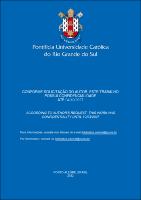| Share record |


|
Please use this identifier to cite or link to this item:
https://tede2.pucrs.br/tede2/handle/tede/10500| Document type: | Dissertação |
| Title: | Efeito dos fármacos ácido zoledrônico e sunitinibe sobre a vasculatura da maxila de ratos |
| Author: | Maccari, Giovana Prediger  |
| Advisor: | Cherubini, Karen |
| Abstract (native): | A osteonecrose dos maxilares associada ao uso de medicamentos (MRONJ) é um efeito adverso de fármacos antirreabsortivos e antiangiogênicos. Desde 2003, esse efeito adverso vem sendo estudado, entretanto sua etiopatogênese ainda não foi completamente esclarecida. Diversas teorias já foram propostas, entre elas, a de que o possível efeito antiangiogênico dos bisfosfonatos seria um dos fatores responsáveis por promover a lesão. O presente estudo teve como objetivo quantificar a vasculatura e a expressão de VEGF (fator de crescimento do endotélio vascular) em maxila de ratos tratados com ácido zoledrônico e/ou sunitinibe. Ratos Wistar (n=52) foram distribuídos em quatro grupos de acordo com o tratamento administrado: (1) Sunitinibe (n=13); (2) Sunitinibe/ácido zoledrônico (n=13); (3) Ácido zoledrônico (n=13); (4) Grupo-controle (n=13). Após 15 dias de tratamento, os molares superiores do lado direito foram extraídos. Aos 21 dias do período pós-operatório, os animais foram submetidos a eutanásia, e as maxilas foram dissecadas para posterior exame histomorfométrico. A proporção de vasos sanguíneos e a expressão de VEGF foram quantificadas tanto no lado da maxila não submetido a exodontias (região do dente), quanto no lado em que foram realizadas as exodontias (região de exodontia). Foram avaliados os sítios: osso alveolar, mucosa oral e polpa dentária. Na região do dente, na análise em H&E, não houve diferença significativa da quantificação de vasos entre os grupos em nenhum dos sítios avaliados; enquanto o VEGF teve menor expressão na mucosa oral do grupo sunitinibe/ ácido zoledrônico quando comparado ao grupo-controle. Na região de exodontia, na análise H&E, os grupos sunitinibe e sunitinibe/ácido zoledrônico tiveram maior quantidade de vasos na mucosa oral, se comparados ao grupo ácido zoledrônico; no osso alveolar, essa variável foi maior no grupo sunitinibe do que no grupo ácido zoledrônico. Ainda considerando a região de exodontia, houve maior expressão de VEGF na mucosa oral do grupo sunitinibe, quando comparado com o controle, e também no osso alveolar do grupo-controle quando comparado aos demais grupos. Conclusão: O ácido zoledrônico e o sunitinibe parecem ter efeitos distintos na vasculatura e na expressão de VEGF de acordo com o local da maxila analisado. A expressão de VEGF não representa o efeito antiangiogênico do sunitinibe. |
| Abstract (english): | Medication-related osteonecrosis of the jaw (MRONJ) is an adverse effect of antiresorptive and antiangiogenic drugs. It occurs mainly in patients undergoing intravenous bisphosphonate administration. Even though this adverse effect has been investigated since 2003, its etiopathogenesis has not still been completely understood. Several theories have been proposed, including the possible antiangiogenic effect of bisphosphonates being one of the factors responsible for the lesion development. The present study aimed to analyze the vasculature and the expression of VEGF (vascular endothelial growth factor) in the maxilla of rats treated with zoledronic acid and/or sunitinib. Wistar rats (n=52) were allocated into four groups according to the treatment administered: (1) Sunitinib (n=13); (2) Sunitinib/zoledronic acid (n=13); (3) Zoledronic acid (n=13); (4) Control group (n=13). After 15 days of treatment, the upper right molars were extracted. On postoperative day 21, animals were euthanized, and the maxillae were histomorphometrically analyzed. The proportion of blood vessels and VEGF expression were quantified in both sides of maxilla (tooth region and tooth extraction region). Alveolar bone, oral mucosa and dental pulp were the sites evaluated. In the tooth region, vessel quantification in the H&E analysis did not show significant differences between groups, whereas VEGF staining was less in the oral mucosa of the sunitinib/zoledronic acid group than in the control. In the tooth extraction region, vasculature in the oral mucosa was greater in the sunitinib and sunitinib/zoledronic acid groups than zoledronic acid group, with no significant difference from the control. Still in the tooth extraction region, vasculature was greater in the alveolar bone of the sunitinib compared to zoledronic acid group and VEGF staining was greater in the oral mucosa in the sunitinib group compared to control, whereas in the alveolar bone, it was greater in the control compared to all other groups. Conclusion: Zoledronic acid and sunitinib seem to have distinct effects on vasculature and VEGF expression according to the site of maxilla analyzed. VEGF immunostaining does not seem to represent the sunitinib antiangiogenic effect. |
| Keywords: | Angiogênese Vasculatura VEGF Ácido Zoledrônico Bisfosfonatos |
| CNPQ Knowledge Areas: | CIENCIAS DA SAUDE::ODONTOLOGIA |
| Language: | por |
| Country: | Brasil |
| Publisher: | Pontifícia Universidade Católica do Rio Grande do Sul |
| Institution Acronym: | PUCRS |
| Department: | Escola de Ciências Saúde e da Vida |
| Program: | Programa de Pós-Graduação em Odontologia |
| Access type: | Acesso Aberto |
| Fulltext access restriction: | Trabalho será publicado como artigo ou livro |
| Time to release fulltext: | 60 meses |
| Date to release fulltext: | 04/10/2027 |
| URI: | https://tede2.pucrs.br/tede2/handle/tede/10500 |
| Issue Date: | 29-Jul-2022 |
| Appears in Collections: | Programa de Pós-Graduação em Odontologia |
Files in This Item:
| File | Description | Size | Format | |
|---|---|---|---|---|
| DIS_GIOVANA_PREDIGER_MACCARI_CONFIDENCIAL.pdf | GIOVANA_PREDIGER_MACCARI_DIS | 442.32 kB | Adobe PDF |  Download/Open Preview |
Items in DSpace are protected by copyright, with all rights reserved, unless otherwise indicated.




